- News
- Reviews
- Bikes
- Accessories
- Accessories - misc
- Computer mounts
- Bags
- Bar ends
- Bike bags & cases
- Bottle cages
- Bottles
- Cameras
- Car racks
- Child seats
- Computers
- Glasses
- GPS units
- Helmets
- Lights - front
- Lights - rear
- Lights - sets
- Locks
- Mirrors
- Mudguards
- Racks
- Pumps & CO2 inflators
- Puncture kits
- Reflectives
- Smart watches
- Stands and racks
- Trailers
- Clothing
- Components
- Bar tape & grips
- Bottom brackets
- Brake & gear cables
- Brake & STI levers
- Brake pads & spares
- Brakes
- Cassettes & freewheels
- Chains
- Chainsets & chainrings
- Derailleurs - front
- Derailleurs - rear
- Forks
- Gear levers & shifters
- Groupsets
- Handlebars & extensions
- Headsets
- Hubs
- Inner tubes
- Pedals
- Quick releases & skewers
- Saddles
- Seatposts
- Stems
- Wheels
- Tyres
- Health, fitness and nutrition
- Tools and workshop
- Miscellaneous
- Cross country mountain bikes
- Tubeless valves
- Buyers Guides
- Features
- Forum
- Recommends
- Podcast
review
£1,100.00
VERDICT:
A nice enough cyclo-cross bike with good handling but heavy and overgeared
Weight:
10,420g
Contact:
At road.cc every product is thoroughly tested for as long as it takes to get a proper insight into how well it works. Our reviewers are experienced cyclists that we trust to be objective. While we strive to ensure that opinions expressed are backed up by facts, reviews are by their nature an informed opinion, not a definitive verdict. We don't intentionally try to break anything (except locks) but we do try to look for weak points in any design. The overall score is not just an average of the other scores: it reflects both a product's function and value – with value determined by how a product compares with items of similar spec, quality, and price.
What the road.cc scores meanGood scores are more common than bad, because fortunately good products are more common than bad.
- Exceptional
- Excellent
- Very Good
- Good
- Quite good
- Average
- Not so good
- Poor
- Bad
- Appalling
Bianchi's Zurigo sends mixed messages with its knobbly tyres and compact road gearing. It's heavy and under specced compared with similarly priced rivals, but there's a gem of a bike here and it's a lot of fun as a multi-terrain machine for exploring the local bridleway network, or as a versatile weekend warrior and daily commuter, with space for big tyres and eyelets for mudguards and a rack.
Ride and handling
There's a lot to like about the Zurigo, and I don't just mean the celeste paint job, which still draws admiring glances wherever I go. The aluminium frame and carbon fibre fork provide a stiff and responsive ride and it hops over tree roots or pavement kerbs with enthusiasm.
The carbon fork helps to tame some of the vibration up front but it's still a crisp ride, occasionally erring on harsh. A bigger volume tyre than the 32mm Kenda Kwickers fitted helped smooth out the ride, as did lowering the tyre pressure. While many road bikes will, at a pinch, take a 28mm tyre, the Zurigo will happily accommodate up to 38mm, opening up your tyre choice plenty.
Find your nearest dealer here
Buy this online here
It's fun and exciting on the trail, stable and surefooted on the road, easily making the transition between different surfaces and riding styles. The handling is fast but not twitchy. The slightly slacker head angle provides slower steering responses than a regular road race bike. The Zurigo displays a level of agility that makes it a sweet ride through twisting tree-lined trails. With a change to a slicker tyre it's equally at home on the road, and provides good confidence on high speed descents and more challenging downhills on country lanes with a rough and potholed surface.
These qualities make it a good choice for a bike that can be pressed into service as a daily commuter with a bit of towpath or bridleway added to the mix. By changing the tyre (I fitted the Panaracer GravelKing), the Zurigo transforms into what you might want to call a gravel and adventure bike: fast and comfortable on the road, agile and capable on the dirt.
I tested it as a cyclo-cross bike, too, taking it onto mountain bike trails and exploring the local woods, and with the stock tyres it is quite at home. Anyone serious about racing 'cross will find the weight and gearing a handicap, though; before the weight can tug at your legs the gearing will force you to dismount on really hilly and steep terrain.

It's adventure and multi-surface riding that the Zurigo excels at. With that change of tyre, the Bianchi can easily hop from the road into the trail. From commuting to training rides, it's a competent road bike, with the compact gearing providing good top-end speed and the 12-30 cassette helping you up the steepest climbs. Yet it's equally at home exploring the local bridleways and byways, along with any towpaths that might provide the opportunity to escape the heavily congested roads. And with the mudguard mounts, it would make an ideal winter bike too.

Frame and equipment
Bianchi uses 6000-series aluminium for the Zurigo frame, with triple butted tubes to save weight and hydroforming to shape the tubes, most noticeably the top tube which bows gently from the head tube to the seat tube.
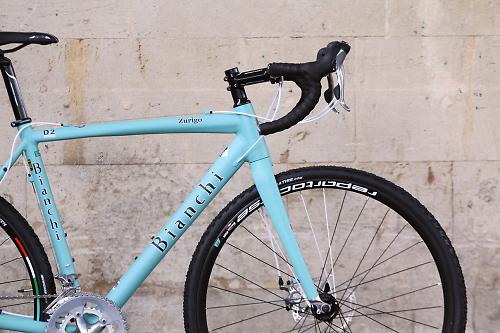
The gear cables are routed along the top tube, while the rear brake cable, with a full run of outer casing, enters the right side of the down tube and pops out of the left side just before the seat tube, and is then externally routed along the top of the chainstay. Routing the gear cables along the top tube ensures that gears continue to shift when riding in the muck, and don't get in the way when you're shouldering the bike. The internal brake cable is a nice aesthetic touch, but it did rattle noisily on odd occasions.
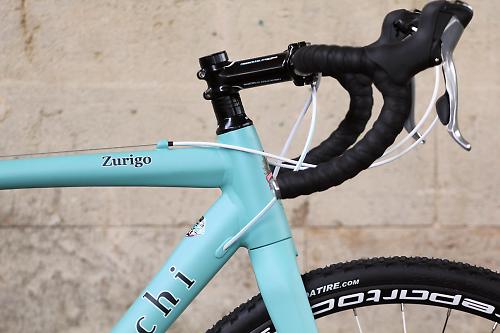
The frame has a PF30 bottom bracket and a tapered head tube, into which slots a carbon fibre fork. There's stacks of mud clearance around the fork and rear stays.
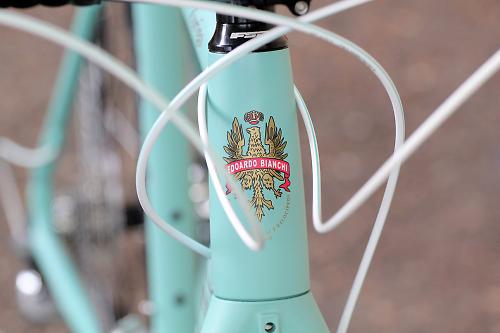
As for the geometry, well the Zurigo isn't that too removed from the Infinito CV endurance road bike, which I tested in 2013. It has 425mm chainstays and the bottom bracket drop (below the horizontal between wheel axles) is 65mm, higher than a road bike. The head tube on this 55cm model is short at 14cm, but remember that the fork is taller than a road fork. The stack is 556mm and the reach 384mm (the vertical and horizontal measurements between the centre of the bottom bracket and the top of the head tube).
You can tell Bianchi is aiming the Zurigo at those cyclists drawn to the versatility of a cyclo-cross bike as much as those wanting to get into cyclo-cross racing, because there are mudguard eyelets on the frame and fork, and you can fit a rear rack.
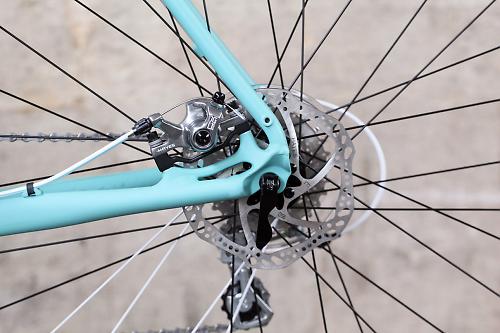
The bike comes with 32mm Kenda Kwicker tyres, a knobbly tread ideal for British winter mud. The frame and fork will accept up to 38mm tyres, and to turn the bike into a more rounded 'gravel/adventure' bike, I swapped the tyres for the excellent Panaracer GravelKing and injected a bit more pace for riding on the road, with enough tread to allow off-road excursions.
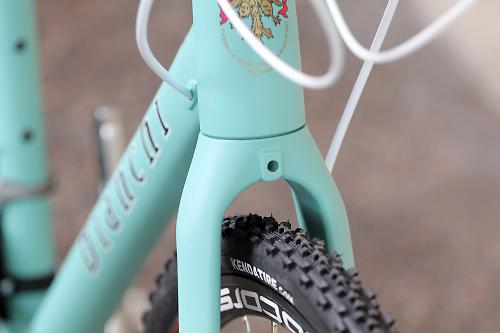
You can choose the Zurigo in three builds, with this £1,100 model the most affordable of the bunch. It's built up with a Shimano Tiagra groupset with a 50/34 compact chainset - further indication of the sort of riding Bianchi expects this bike to be used for - with a wide range 12-30 cassette bolted to the rear hub. It's a 10-speed groupset and provides a nice spread of gears, but for extended off-road riding that 50-tooth ring can prove a bit tall.

As nice as Tiagra is (though there's a new version in the pipeline) it's worth pointing out that it is possible to spend similar money and walk away with a Shimano 105-equipped bike. Canyon's excellent Inflite AL 8.0 is another £100 but provides a full Shimano 105 11-speed groupset with a 'cross-friendly 46/36 chainset. Yes, the Bianchi has the history, the race heritage, the style, the celeste. But if you want the best return on your investment, shopping around does reveal more generously equipped bikes.
The brakes are Hayes mechanical discs with 160mm rotors. They work well enough, though lacking much in the way of bite, but they do get better after a short bedding in period. I didn't experience any rub or judder, and the braking is predictable and assured, a treat if you're used to the inadequate cantilever brakes typical of a cyclo-cross bike.
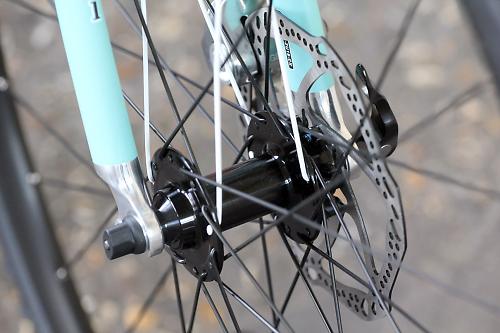
The wheels are branded up with the Reparto Corse label, Bianchi's own parts label, with an aluminium rim laced to smooth-running hubs.

The Reparto Corse name extends to the aluminium bar, stem and seatpost, and there's a San Marco Era Start Power saddle atop the post.
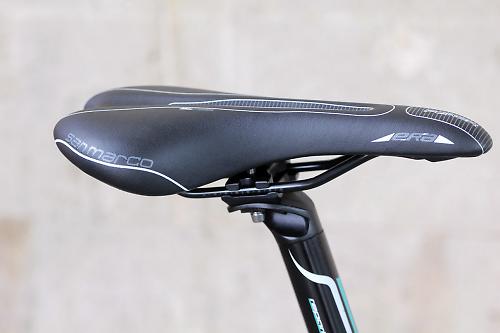
On the scales the Zurigo isn't going to win any prizes, coming in at 10.42kg (22.97lb) for the 55cm bike on test here.
Conclusion
The Zurigo is a lot of fun. It's agile, stable and pretty fast. It's sold with the wrong tyres, though. At the moment, with a knobbly 'cross tyre and compact road gearing, it's sending mixed messages. Change the tyres to a multipurpose design like the Panaracer GravelKing and you have a bike that is ideal for commuting and adding some dirt and gravel riding to your road riding; as a cyclo-cross race bike it's heavy and overgeared.
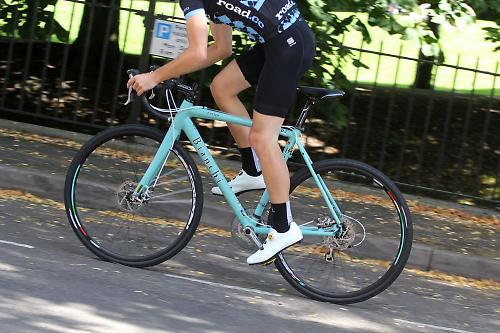
Verdict
A nice enough cyclo-cross bike with good handling but heavy and overgeared
road.cc test report
Make and model: Bianchi Zurigo cyclocross bike
Size tested: 55cm, celeste
About the bike
State the frame and fork material and method of construction. List the components used to build up the bike.
Bianchi Zurigo 7005 hydroformed alloy frame.
Bianchi Zurigo 6061 1 1/8" carbon fork (alu steerer).
FSA TH-CX headset.
Shimano Tiagra 20 speed compact groupset - 50/34T chainset.
Hayes mechanical discs
Reparto Corse disc wheels
Kenda Kwicker tyres
Bianchi Reparto compact alloy "Wing" handlebars.
Bianchi Reparto Corse stem.
Bianchi Reparto Corse 31.6mm seatpost.
San Marco Era Start Power saddle.
Tell us what the bike is for, and who it's aimed at. What do the manufacturers say about it? How does that compare to your own feelings about the bike?
Bianchi says: "Mud, grass, steep hills, obstacles and speed. These words perfectly describe cyclo-cross and Bianchi's bikes are designed to support riders through challenges of this adrenaline fuelled event."
Frame and fork
Overall rating for frame and fork
8/10
Tell us about the build quality and finish of the frame and fork?
The frame and fork are very tidily finished with smooth welds and neat details, and the cable routing is smartly done.
Tell us about the materials used in the frame and fork?
Hydroformed and triple butted 7005 aluminium with a carbon fork, though the steerer tube is aluminium.
Tell us about the geometry of the frame and fork?
A bit slacker at the front to increase steering stability which helps when heading off road, and the higher bottom bracket provides more pedal clearance to obstacles.
How was the bike in terms of height and reach? How did it compare to other bikes of the same stated size?
Reach and stack felt about right, though I did change to a longer stem.
Riding the bike
Was the bike comfortable to ride? Tell us how you felt about the ride quality.
The frame is quite stiff but the carbon fork helps to smooth the vibrations from the front. Running the tyres nice and soft helps.
Did the bike feel stiff in the right places? Did any part of the bike feel too stiff or too flexible?
Stiff and responsive handling. It works well on the road and off it too, eating up single track and dirt trails with confidence and stability from the slacker head angle.
How did the bike transfer power? Did it feel efficient?
It's very direct and responsive to power input.
Was there any toe-clip overlap with the front wheel? If so, was it a problem?
No.
How would you describe the steering? Was it lively, neutral or unresponsive? Quite relaxed.
Tell us some more about the handling. How did the bike feel overall? Did it do particular things well or badly?
The steering is relaxed and a little slower, which prevents it from getting twitchy when riding bumpy terrain.
Which components had the most effect (good or bad) on the bike's comfort? would you recommend any changes?
I changed the tyre for a faster-rolling treaded type to make it faster on the road without losing too much of its off-road capability, at least on dry trails.
Which components had the most effect (good or bad) on the bike's stiffness? would you recommend any changes?
The large diameter aluminium seatpost transfers a lot of the vibration to the saddle; a carbon post might provide a bit more deflection.
Which components had the most effect (good or bad) on the bike's efficiency? would you recommend any changes?
Just the tyres as already mentioned, a faster-rolling tyre better matches the compact road gearing.
Rate the bike for efficiency of power transfer:
8/10
Rate the bike for acceleration:
6/10
The high weight makes rapid acceleration and sprinting hard work.
Rate the bike for sprinting:
7/10
Rate the bike for high speed stability:
8/10
Rate the bike for cruising speed stability:
8/10
Rate the bike for low speed stability:
8/10
Rate the bike for flat cornering:
8/10
Rate the bike for cornering on descents:
9/10
Rate the bike for climbing:
6/10
The weight hurts its performance on the climbs, but the big cassette certainly helps you out on the steeper gradients.
The drivetrain
Rate the drivetrain for performance:
8/10
Nice, but could be better for the price.
Rate the drivetrain for durability:
8/10
Rate the drivetrain for weight:
6/10
Rate the drivetrain for value:
8/10
Tell us some more about the drivetrain. Anything you particularly did or didn't like? Any components which didn't work well together?
Tiagra all works really well.
Wheels and tyres
Rate the wheels and tyres for performance:
7/10
Rate the wheels and tyres for durability:
8/10
Rate the wheels and tyres for weight:
7/10
Rate the wheels and tyres for comfort:
7/10
Rate the wheels and tyres for value:
8/10
Tell us some more about the wheels and tyres.Did they work well in the conditions you encountered? Would you change the wheels or tyres? If so, what for?
Stiff and reliable wheels, just change the tyres if you want to use the Zurigo on mixed surfaces, road and dirt.
Controls
Rate the controls for performance:
8/10
Rate the controls for durability:
8/10
Rate the controls for weight:
7/10
Rate the controls for comfort:
7/10
Rate the controls for value:
8/10
Tell us some more about the controls. Any particularly good or bad components? How would the controls work for larger or smaller riders?
Didn't really get on with the saddle, but that's personal preference, and I swapped the stem for a longer one.
Anything else you want to say about the componentry? Comment on any other components (good or bad)
It all works really well.
Your summary
Did you enjoy riding the bike? Yes
Would you consider buying the bike? Probably not
Would you recommend the bike to a friend? Yes
Rate the bike overall for performance:
8/10
Rate the bike overall for value:
5/10
Use this box to explain your score
The Zurigo is a lot of fun. It's agile, stable and pretty fast. It's sold with the wrong tyres, though, sending mixed messages with its knobbly 'cross tyres and compact road gearing. Change the tyres to more multipurpose ones and you have a bike that is ideal for commuting and adding some dirt and gravel riding to your road riding. As a cyclo-cross race bike it's heavy and overgeared.
About the tester
Age: 31 Height: 180 Weight: 67
I usually ride: My best bike is:
I've been riding for: 10-20 years I ride: Every day I would class myself as: Expert
I regularly do the following types of riding: road racing, time trialling, cyclo-cross, commuting, touring, mountain biking
David worked on the road.cc tech team from 2012-2020. Previously he was editor of Bikemagic.com and before that staff writer at RCUK. He's a seasoned cyclist of all disciplines, from road to mountain biking, touring to cyclo-cross, he only wishes he had time to ride them all. He's mildly competitive, though he'll never admit it, and is a frequent road racer but is too lazy to do really well. He currently resides in the Cotswolds, and you can now find him over on his own YouTube channel David Arthur - Just Ride Bikes.
Latest Comments
- chrisonabike 1 sec ago
Unfortunately we've already had a child killed in just such circumstances and a grown man, apparently a "professional driver" - given excuses by a...
- AidanR 8 min 28 sec ago
It appears that the bars and seatpost are included. Can't help you on the BB nor the tyre clearance.
- mrchrispy 14 min ago
I urge anyone with a soul to buy this, its beautiful, beautiful thing.
- quiff 50 min 54 sec ago
There's a couple of schools near us that have instituted regular (but not daily) bike buses and they have huge takeup - to the extent that some...
- Rendel Harris 46 min 56 sec ago
So highly trained collision investigators couldn't establish the speed at which the driver was travelling but the judge, apparently without any...
- Jack Sexty 1 hour 41 min ago
I think the wording was just a bit ambiguous. Have made it clearer that it was the bendy ones they were after.
- mdavidford 2 hours 40 min ago
He's got the outfit sorted already and everything...
- MichaelWinnerRIP 2 hours 47 min ago
Seems like Dynamic Touch-Up is not sold in UK, according to the Dynamic website. Decathlon has a whitener at £4.99. Anybody tried it?
- Surreyrider 2 hours 52 min ago
Exactly - it's a silly headline. Scared = clickbait, not reality.
- maxdabrit 2 hours 52 min ago
$500 (maybe) to get this Silca advertisement in this and other articles in multiple websites . Genius !








































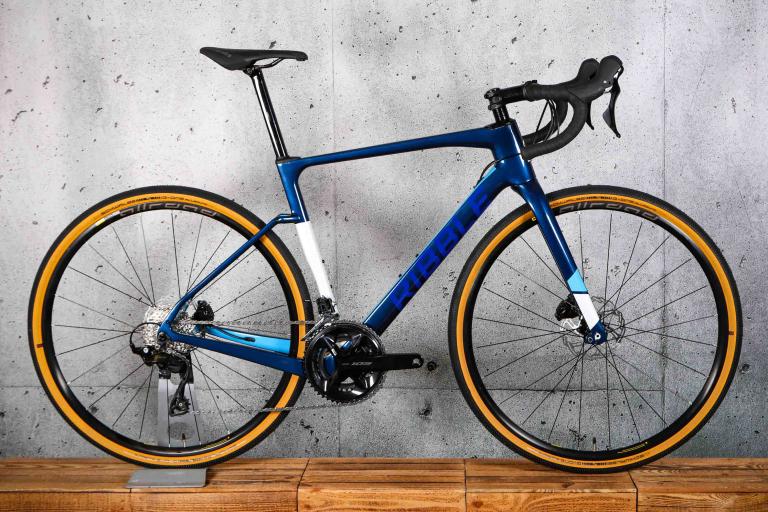
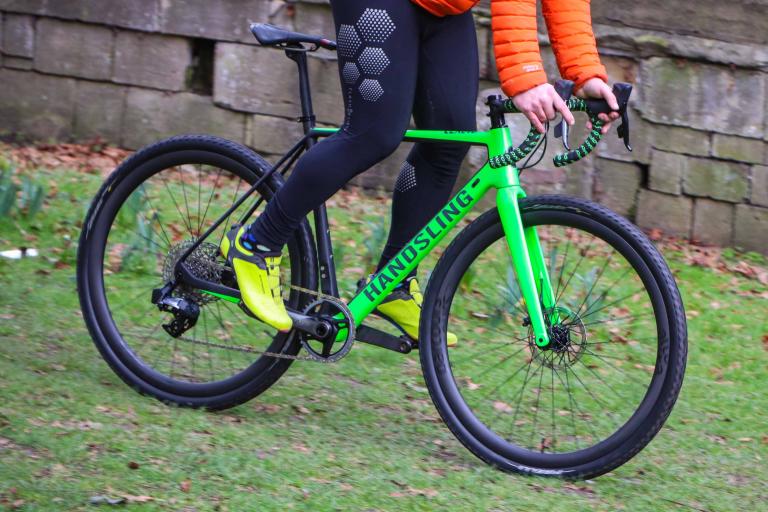

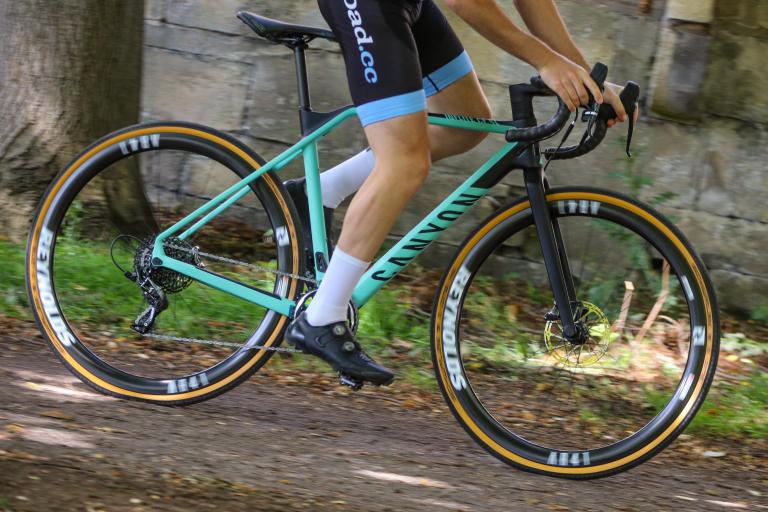
Add new comment
3 comments
I bought the Bianchi Zurigo Disc with 105 a few weeks ago (the black one). I absolutely love it, it doesn't feel heavy to me at all, but I dont have much experience with these types of bike.
I use it for commuting as I feel that disc brakes are a bit safer on London roads in the lashing rain. The chunky tires are certainly good fun having only ridden 23mm slicks on my other bike, but I have bought some 32mm Gatorskins to put on this one for the Summer.
I think the bike looks and feels fantastic, I couldnt be happier with it.
Specifications and weight that are pretty much unacceptable for £1k+ price bracket. A shame, as it's pretty enough that I would have been willing to cut the Zurigo some slack for its looks.
THAT WEIGHT!!!